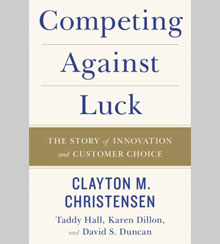strategy+business, August 31, 2016
by Theodore Kinni
 Since 2005, Strategy& has been conducting an annual study of the 1,000 biggest corporate R&D spenders. One conclusion has held true through all 11 installments: There is no statistically significant relationship between the financial performance of the so-called Global Innovation 1000 companies and their R&D spending.
Since 2005, Strategy& has been conducting an annual study of the 1,000 biggest corporate R&D spenders. One conclusion has held true through all 11 installments: There is no statistically significant relationship between the financial performance of the so-called Global Innovation 1000 companies and their R&D spending.The fact that, in 2015, these companies collectively spent US$680 billion buying R&D lottery tickets bothers Harvard disruption guru Clayton Christensen. “Innovation processes in many companies are structured and disciplined and the talent applying them is highly skilled.… From the outside, it looks like companies have mastered an awfully precise, scientific process,” he and coauthors Taddy Hall, Karen Dillon, and David S. Duncan write in Competing Against Luck: The Story of Innovation and Customer Choice (HarperBusiness, 2016). “But the results show that, for most companies, innovation is still hit or miss.”
Christensen and his coauthors think they have an explanation for this conundrum: Companies know a lot about the characteristics and attributes of their customers, but they don’t know why customers buy their products and services. In other words, companies know the correlations between types of customers and their products and services, but they don’t understand what causes customers to buy their offerings. And without grasping causation, they can’t be sure whether their R&D spending will yield a winning ticket.
Competing Against Luck proposes that companies get to causation by asking customers, “What job did you hire that product to do?” This is a question that surely would have warmed the heart of Theodore Levitt, the Harvard Business School professor who immortalized an otherwise forgotten guy named Leo McGivena for saying “Last year one million quarter-inch drill bits were sold — not because people wanted quarter-inch drill bits but because they wanted quarter-inch holes.” But Christensen et al. take McGivena’s insight far beyond Levitt’s interest in customer needs and desires by cobbling together an approach to innovation that they plainly, if a bit clunkily, call the Theory of Jobs to be Done (aka Jobs Theory). Read the rest here















No comments:
Post a Comment